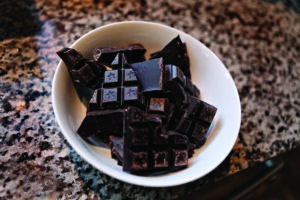A Primer, by Steven C. Wallace
Fine chocolate is one of life’s pleasures and one of society’s permissible vices. Here’s how to do justice to exquisite chocolate.
Step 1: Allow the chocolate bar to come to room temperature. Unwrap the bar and observe the color of the chocolate. Milk chocolates tend towards lighter browns or coffee colors and dark chocolates are, well, darker in color. Be aware of colors which simply don’t look natural or appropriate. Remember, fine dark chocolate contains only four ingredients: cocoa liquor (the intense, bitter, non-alcoholic essence of the cocoa bean), cocoa butter, sugar and a very small amount of a natural emulsifier, such as soy-based lecithin which keeps the cocoa butter and cocoa liquor from separating. Milk chocolate contains milk in addition to the four ingredients above. Myth: While the labels on milk chocolate often show an enticing pitcher of cold, frothy milk, actual chocolate production does not use milk in liquid form. Look for the use of a full cream milk powder, instead of skim milk powder, for maximum flavor. Fine chocolates do not contain artificial flavorings or colors. There should not be a white powder or bloom on the surface of the chocolate. Bloom occurs when the cocoa liquor and cocoa butter separate; the condition will not make you sick, it merely looks unappetizing.
Step 2: Hold the bar firmly between the thumb and forefinger at each end and briskly snap the bar in half. Fine chocolate should give a satisfying snap and result in a smooth surface along the break. You don’t want a chocolate to crumble or be unduly “soft”.
Step 3: Sample the chocolate’s aroma by inhaling along the surface of the break. The aroma should be subjectively pleasing and smell like cocoa. The best way to sample aromas is to compare several different chocolate bars at one sampling. You will likely notice quite a difference in aroma between chocolates — you don’t want a chemical or plastic smell or a curious lack of aroma altogether.
Step 4: Fine chocolate melts at body temperature. If you hold the chocolate in your hand for a minute or so, you should notice that it begins to melt.
Step 5: Taste the chocolate. Place it on your tongue for a moment before chewing and gently press it against the roof of your mouth. Again, fine chocolate melts at body temperature and the chocolate should begin to dissolve just slightly on your tongue–beware of chocolate that causes you to break a tooth! Chew and swallow. Taste is entirely subjective; texture is not. You should not feel a waxy presence on the roof of your mouth, nor should the texture be especially granular. Smoothness is key. A smooth texture and superb melting point indicates the chocolatier did not skimp on costly cocoa butter.
Step 6: Do you sense a slight, subtle, fruity aftertaste? Especially fresh, natural chocolate should result in an aftertaste that may just hint of raspberries, for example. Enjoy!

